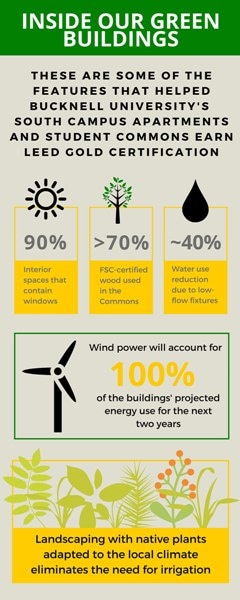Mar 7 2016
Opened for the fall 2015 semester, the South Campus Apartments and adjacent Student Commons Building at Bucknell University were designed to provide students an appealing space to live, study, grab a bite to eat, host events and relax. They were also designed to do all that as perhaps the most sustainable buildings on campus, a national environmental consortium recently confirmed.

In January, the Student Commons became the first building on the Bucknell campus to receive Leadership in Energy and Environmental Design (LEED) Gold certification from the U.S. Green Building Council. It was followed in February by the South Campus Apartments, which also earned LEED Gold. The certifications represent an accomplishment the University plans to build on.
"As an educational institution we have an obligation to develop our students to be leaders in areas such as sustainability, and we need to set an example of sustainable practices in all areas, including reducing the environmental impact of building new and renovating existing facilities," said Mike Patterson, Bucknell's executive director for facilities. "As with anything else, we will continue to look for ways we can improve in this area."
The Green Building Council's rubric for conferring LEED certification takes into account sustainable design features such as the use of recycled and regionally sourced materials, and measures for reducing water consumption and optimizing energy use. It also factors in more holistic elements such as development density and community connectivity, for which both the South Campus Apartments and Commons Building were awarded the maximum five out of five points.
The new residence life complex was built with more than 10 percent recycled material (18 percent for the Commons). More than 60 percent of waste generated during the Commons' construction, and 75 percent from the South Campus Apartments' construction, was diverted from landfills. More than three-quarters of construction lumber used in the Commons Building was sourced from sustainable forests to reduce environmental impacts, while all composite wood, paints, flooring, adhesives and sealants in the buildings are low volatile organic compound-emitting, reducing indoor air contaminants.
Other sustainable design features of the complex include ample incorporation of low heat-emitting windows, which reduce the need for artificial light during the day, and occupancy sensors that shut off lights automatically when rooms aren't in use. Low-flow water fixtures cut water consumption by more than a third, while the use of native plants for outdoor landscaping eliminates the need to use potable water for irrigation. | Read more about the green features of the South Campus Apartments here and the Commons Building here.
A focus on sustainability will guide the construction of future buildings as well. University policy dictates that all new buildings are designed to meet or exceed LEED Silver standards, and Bucknell has also signed on to the American College & University Presidents' Climate Commitment, which requires the same. For major renovations, Bucknell Facilities also works to ensure that major renovations are also at least LEED certified. Sustainability is also a core initiative of the WE DO Campaign for Bucknell University.
Bucknell's first LEED-certified buildings were the Lambda Chi Alpha and Kappa Delta Rho fraternity houses constructed in 2012, followed by Academic West in 2013. All three received LEED Silver certification. Bucknell will also seek LEED certification for the Graham Building, expected to open in the fall.
"Obtaining any LEED certification demonstrates Bucknell's commitment to sustainability and minimizing our impact on the environment," Patterson said. "While we already do many of these things as part of our planning and design process, having a rigorous review and certification process provides a definitive indication of that commitment."
The University is currently seeking input from students, faculty and staff to factor into the design of its next planned construction project, Academic East.